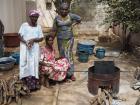Der Rabat-Prozess in Stichworten (deutsch und englisch)
Bereits seit 2006 verhandeln mehrere Dutzend afrikanische und europäische Regierungen im Rahmen des Rabat-Prozesses über unterschiedliche Maßnahmen, die so genannte irreguläre Migration insbesondere aus West- und Nordafrika Richtung Europa einzudämmen. Ähnlich wie der 2014 begonnene Karthoum-Prozess (an dem vor allem ostafrikanische und europäische Regierungen beteiligt sind) ist der Rabat-Prozess durch den afrikanisch-europäischen Regierungsgipfel im November 2015 in der maltesischen Hauptstadt Valetta enorm intensiviert worden. Dennoch sind die Übergänge zwischen dem Rabat-Prozess, dem Valetta-Prozess und bilateralen afrikanisch-europäischen Verhandlungen fließend. In diesem Sinne sind an dieser Stelle keine weitergehenden Informationen zum Rabat-Prozess dokumentiert (jenseits einiger Basisinformationen auf englisch). Verwiesen sei stattdessen auf die Menüpunkte Frontex // Grenzregime und Valetta-Prozess sowie die einzelnen Länder (Mali, Senegal, Togo, Marokko und Niger), wo sämtliche Informationen zum Rabat-Prozess auf die eine oder andere Weise enthalten sind.
Offizielle Informationen zum Rabat-Prozess (englisch)
In July 2006, European and African ministers in charge of migration and development issues gathered in Rabat. They decided to work together on offering a concrete and appropriate response to these fundamental issues, based on the strong conviction that well-managed migration represents an opportunity for individuals and states in Africa and in Europe. Moreover, this should be anchored in the principles of combating poverty, promoting sustainable development and co-development, and respecting the rights and dignity of migrants and refugees. The Rabat Process was born, launching a balanced, pragmatic and operational mechanism of cooperation among countries of origin, transit and destination of migrants coming from West and Central Africa.
In the framework of this Euro-African dialogue, more than 60 countries and organisations gather regularly to discuss questions of migration and development at technical and senior official levels, while Euro-African ministerial conferences define the strategic objectives. Four ministerial conferences have so far taken place, hosted by key stakeholders of the dialogue:
- 2006: Morocco, adoption of the Rabat Action Plan
- 2008: France, adoption of the Paris Cooperation Programme
- 2011: Senegal, adoption of the Dakar Strategy
- 2014: Italy, adoption of the Rome Declaration and Programme
The Rome Programme 2014–2017
The strategic framework in place until 2017, the Rome Programme, took the Rabat Process' balanced approach to migration one step further by introducing international protection as the fourth pillar structuring the dialogue:
- organising mobility and legal migration (pillar 1)
- improving border management and combating irregular migration (pillar 2)
- strengthening the synergies between migration and development (pillar 3)
- promoting international protection (pillar 4).
Partner countries are encouraged to implement concrete actions pursuing the objectives of the programme. The Rome Programme is therefore in full accordance with the Dakar strategy by emphasising the importance of operationalising the dialogue. The Rome Programme puts forward two thematic priority areas to focus efforts:
- strengthening the link between migration and development by emphasising, in particular, the identification of root causes of migration and the role of the diaspora
- preventing and fighting against irregular migration and related crimes, with particular attention to border management and return policies, including voluntary return and readmission, in full respect of human rights.
In order to support Rabat Process partner countries in pursuing concrete actions, the European Commission is financing the Rabat Process Support Project.
The Guiding Principles
As defined in the Dakar Strategy, the dialogue is based on the following five principles.
Working dialogue
The Rabat Process is based on dialogue which is orientated towards action.
A flexible and balanced approach
The Process is adapted to the development of migratory movements and the needs of the partner countries. It keeps a balance between the three pillars of the process: organising legal migration, combating irregular migration, and reinforcing the synergies between migration and development.
A coherent dialogue
The Process represents the main framework for regional dialogue within the Global Approach to Migration with regard to migration from West and Central Africa. It is the driving force behind initiatives implemented at bilateral, subregional, regional and multilateral levels by the members of the Rabat Process.
Committed partners
The Process is intergovernmental and is open to a certain number of partner organisations. Civil society, migrant associations, social partners, private sector and local and regional authorities have a crucial part to play. The steering committee is responsible for directing and driving the process.
A shared responsibility
The partnership's intention is to manage migratory movements between countries of origin, transit and destination in the best way possible and in a spirit of shared responsibility.



